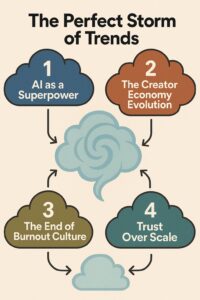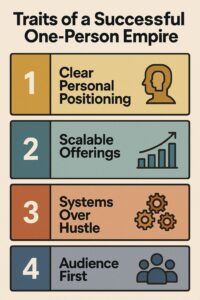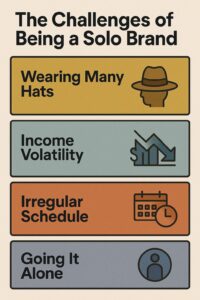Solo Brands Are the New Startups: Building a One-Person Empire in 2025
The entrepreneurial landscape in 2025 looks starkly different from the era of Silicon Valley garage startups and fast-scaling tech unicorns. Today, the rise of the solo brand — a business led by a single individual leveraging digital tools, AI, and personal branding — is redefining what it means to be a successful entrepreneur. No longer is it necessary to raise millions, build large teams, or rent out co-working spaces to launch something impactful. Welcome to the age of one-person empires.
The Rise of the Solo Brand
Over the past decade, the barrier to entry for starting a business has dropped dramatically. With free or low-cost platforms like Substack, Shopify, Gumroad, Canva, and Notion — paired with the explosive rise of generative AI — the playing field has never been more accessible.
What began as a movement of freelancers and creators finding independence has now matured into a legitimate business model: the solo brand. These are individuals who operate as a full-fledged brand — offering products, services, digital content, or communities — all without traditional infrastructure.
In 2025, a solo entrepreneur can:
• Use AI to design and write content,
• Automate marketing with no-code tools,
• Sell products globally via drop-shipping,
• Run a membership community through platforms like Circle,
• Offer courses or coaching through platforms like Teachable or Skool,
• And handle customer service with intelligent bots.
This isn’t side hustle culture. It’s empire-building at a personal scale.
Why Now? The Perfect Storm of Trends
Several macro trends have fueled this shift:
1. AI as a Superpower
AI is no longer experimental — it’s practical. Tools like ChatGPT, Midjourney, Claude, and dozens of niche AI apps can do the work of multiple employees in minutes. From creating content to coding websites to analyzing marketing data, solo founders are supercharged.
2. The Creator Economy Evolution
The creator economy has matured from YouTubers and influencers to niche knowledge workers and domain experts. You don’t need millions of followers — just a few thousand true fans willing to pay for value, authenticity, or insight. In this world, micro is mighty.
3. The End of Burnout Culture
The “hustle till you drop” narrative is fading. Creators and entrepreneurs are looking for sustainable independence — not grind-driven growth. The solo brand offers high autonomy, low overhead, and often better mental health.
4. Trust Over Scale
People are fatigued by faceless corporations and AI-generated noise. They crave authenticity and human connection. A solo brand, with a real person behind it, feels more relatable, trustworthy, and transparent.

Traits of a Successful One-Person Empire
You might be wondering: what separates successful solo brands from just hobbyists or freelancers? Here are the key traits:
1. Clear Personal Positioning
A one-person brand thrives on clarity. You’re not just selling a product or service — you’re selling your unique perspective. Whether you’re a minimalist designer, a mental health advocate, or a productivity guru, your personal story becomes your edge.
2. Scalable Offerings
Successful solo founders move beyond 1:1 freelancing into scalable revenue:
• Digital products (eBooks, templates, toolkits)
• Courses or coaching
• Memberships or communities
• Affiliate income or partnerships
These income streams don’t require you to trade hours for dollars.
3. Systems Over Hustle
Running a one-person business requires operational excellence — using automation, delegation (virtual assistants or AI), and repeatable systems. The best solo entrepreneurs don’t work more; they work smarter.
4. Audience First
Most solo brands are audience-led. Instead of building in secret, they share in public — documenting their journey, learning in real-time, and building trust. Platforms like Twitter/X, LinkedIn, YouTube, and newsletters are the primary engines of growth.

Examples of Thriving Solo Brands in 2025
To understand the power of the solo brand movement, look at examples like:
• Justin Welsh – built a $5M+ solo business through content, courses, and community, all without employees.
• Ali Abdaal – transitioned from a doctor to a productivity educator, building a media empire around content, courses, and products.
• Dan Koe – operates a minimalist one-man brand focused on creative independence, digital leverage, and philosophical entrepreneurship.
• Steph Smith – an example of combining personal expertise with scalable content and tools, while staying authentic and solo.
These individuals have built audiences, monetized intellectual property, and created lives on their own terms — all without investors, large teams, or traditional startup structures.
How to Start Your Own One-Person Empire
If this movement excites you, here’s how you can begin your solo brand journey:
Step 1: Identify Your Niche + Strength
What are you uniquely good at? What do people constantly ask your advice on? Whether it’s design, writing, coding, wellness, finance, or even parenting — there’s an audience for it.
Step 2: Pick Your Platforms
Where will your voice be heard? Choose 1–2 platforms where your audience already hangs out. Twitter/X, LinkedIn, Instagram, YouTube, or Substack are powerful starting points.
Step 3: Start Creating (Consistently)
Content is your distribution. Share your process, insights, mistakes, and lessons. You’re not selling — you’re building trust.
Step 4: Build Your First Product
Start small. This could be:
• A Notion template
• A paid newsletter
• A mini-course
• A digital guide
• A cohort-based workshop
Validate it with your audience and iterate.
Step 5: Automate and Scale
Use tools to automate scheduling, sales, email responses, and marketing. The goal isn’t to do everything — it’s to build systems that do it for you.
Step 6: Invest in Your Brand
Your face, your name, your style — these matter. A clean website, professional design, and cohesive voice build trust and recognition.
The Challenges of Being a Solo Brand
It’s not all passive income and flexible schedules. Some real challenges include:
• Isolation: It can get lonely without a team.
• Overload: You’re the CEO, marketer, support desk, and product creator.
• Uncertainty: Without a fixed salary or funding, income can fluctuate.
• Distractions: Without clear boundaries, work-life blur can happen.
But the trade-offs? Freedom. Ownership. Creative control. And the potential to make a living doing what you love, on your own terms.

The Future: Solo is Serious
By 2030, we may look back at the early 2020s as the birth of the solo founder class — people building six- and seven-figure businesses with little more than a laptop, a clear voice, and a loyal audience.
The solo brand is not just a trend. It’s a paradigm shift — a quieter revolution away from scale-at-all-costs and toward sustainable autonomy.
In 2025, you don’t need a cofounder, venture capital, or a fancy office.
You need:
• A clear purpose.
• An internet connection.
• The courage to show up as yourself.
Welcome to the era of the one-person empire.
